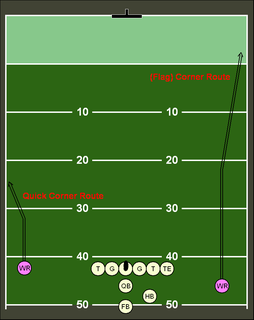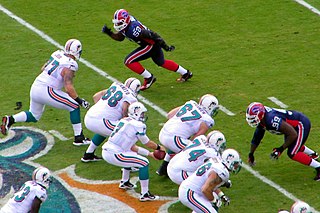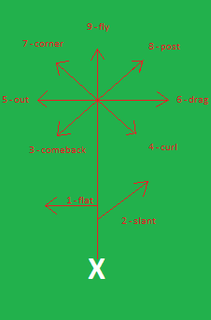
A flat route is an American football route, used in passing plays. A flat route is usually run by a running back or a fullback. When run by a receiver it can be known as a speed out or arrow route. The eligible receiver runs parallel to the line of scrimmage till near the sidelines (in the flat) and turns toward the quarterback to wait for the pass. [1] The QB's pass should arrive when he is not yet past the line of scrimmage. The receiver will then turn upfield at the sideline and run straight down the field.

American football, referred to as football in the United States and Canada and also known as gridiron, is a team sport played by two teams of eleven players on a rectangular field with goalposts at each end. The offense, which is the team with possession of the oval-shaped football, attempts to advance down the field by running with or passing the ball, while the defense, which is the team without possession of the ball, aims to stop the offense's advance and to take control of the ball for themselves. The offense must advance at least ten yards in four downs, or plays; if they fail, they turn over the football to the defense, but if they succeed, they are given a new set of four downs to continue the drive. Points are primarily scored by advancing the ball into the opposing team's end zone for a touchdown or kicking the ball through the opponent's goalposts for a field goal. The team with the most points at the end of a game wins.

A running back (RB) is an American and Canadian football position, a member of the offensive backfield. The primary roles of a running back are to receive handoffs from the quarterback for a rushing play, to catch passes from out of the backfield, and to block. There are usually one or two running backs on the field for a given play, depending on the offensive formation. A running back may be a halfback, a wingback or a fullback. A running back will sometimes be called a "feature back" if he is the team's starting running back.
A wide receiver, also referred to as wideouts or simply receivers, is an offensive position in American and Canadian football, and is a key player. They get their name because they are split out "wide", farthest away from the rest of the team. Wide receivers are among the fastest players on the field. The wide receiver functions as the pass-catching specialist.
The route is used, sometimes as a safety relief if post are covered, with long post, long corner or fly routes, so the safeties and the cornerbacks should be upfield when the pass is caught by the RB or FB. There should be a linebacker covering the RB/FB on these kinds of plays, which is likely to be an easy match for an elusive runner like the running back.

A post is a moderate to deep passing route in American football in which a receiver runs 10–20 yards from the line of scrimmage straight down the field, then cuts toward the middle of the field at a 45-degree angle.

A corner route is a pattern run by a receiver in American football, where the receiver runs up the field and then turns at approximately a 45-degree angle, heading away from the quarterback towards the sideline. Usually, the pass is used when the defensive back is playing towards the inside shoulder of the receiver, thus creating a one on one vertical matchup. The corner route is less likely to be intercepted when compared to the slant route, because it is thrown away from the middle of the field. The pass is used frequently in the West Coast offensive scheme, where quick, accurate throwing is key. The pass may also be used closer to the goal line in what is called a "fade". The quarterback will lob the ball over a beaten defender to a wide receiver at the back corner of the end zone.

A linebacker is a playing position in American football and Canadian football. Linebackers are members of the defensive team, and line up approximately three to five yards behind the line of scrimmage, behind the defensive linemen, and therefore "back up the line". Linebackers generally align themselves before the ball is snapped by standing upright in a "two-point stance".





